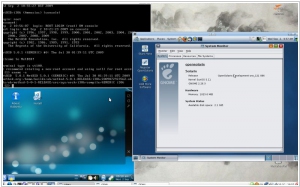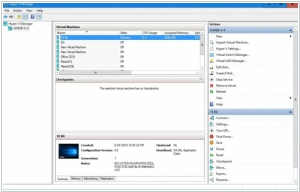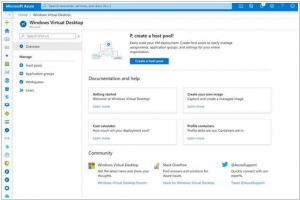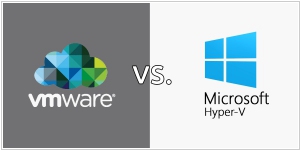KVM vs Microsoft Hyper-V
May 27, 2023 | Author: Michael Stromann
16

KVM (for Kernel-based Virtual Machine) is a full virtualization solution for Linux on x86 hardware containing virtualization extensions (Intel VT or AMD-V). It consists of a loadable kernel module, kvm.ko, that provides the core virtualization infrastructure and a processor specific module, kvm-intel.ko or kvm-amd.ko. KVM also requires a modified QEMU although work is underway to get the required changes upstream.
10

Microsoft Hyper-V provides enterprise-class virtualization for your datacenter and hybrid cloud. Bolster IT efficiency and flexibility with the faster application deployment and maintenance that Microsoft virtualization solutions deliver. Reduce costs by consolidating more workloads on fewer servers and increase agility using the same virtualization platform on-premises and in the cloud.
KVM (Kernel-based Virtual Machine) and Microsoft Hyper-V are both popular virtualization technologies, but they have key differences:
1. Platform Support: KVM is primarily used in the Linux ecosystem and is natively integrated into the Linux kernel, making it the default virtualization solution for many Linux distributions. On the other hand, Microsoft Hyper-V is a hypervisor built into the Windows Server operating system, providing native support for Windows-based virtualization.
2. Maturity and Adoption: KVM has been around for a longer time and has gained significant traction in the Linux community. It is widely used in production environments, especially in cloud computing platforms. Microsoft Hyper-V, as part of the Windows Server ecosystem, has gained popularity in Windows-centric environments and is commonly used for virtualization in Windows-based systems.
3. Licensing and Cost: KVM is open source and available for free, making it an attractive choice for organizations seeking a cost-effective virtualization solution. Microsoft Hyper-V, being a proprietary technology, is part of the Windows Server licensing and may involve additional costs depending on the edition and usage.
4. Management Tools and Ecosystem: KVM is often managed through command-line tools and utilizes open-source management frameworks like libvirt, which provide a variety of options for virtual machine management and orchestration. Microsoft Hyper-V, on the other hand, integrates with the broader Microsoft ecosystem and provides management tools like Hyper-V Manager and System Center Virtual Machine Manager (SCVMM), offering a more integrated experience for Windows-based environments.
5. Integration and Compatibility: KVM integrates well with the Linux ecosystem, leveraging existing technologies and tools commonly used in Linux environments. Microsoft Hyper-V, being a Microsoft product, is tightly integrated with other Microsoft technologies, such as Active Directory, PowerShell, and System Center suite, providing seamless integration and compatibility within the Windows ecosystem.
See also: Top 10 Virtualization platforms
1. Platform Support: KVM is primarily used in the Linux ecosystem and is natively integrated into the Linux kernel, making it the default virtualization solution for many Linux distributions. On the other hand, Microsoft Hyper-V is a hypervisor built into the Windows Server operating system, providing native support for Windows-based virtualization.
2. Maturity and Adoption: KVM has been around for a longer time and has gained significant traction in the Linux community. It is widely used in production environments, especially in cloud computing platforms. Microsoft Hyper-V, as part of the Windows Server ecosystem, has gained popularity in Windows-centric environments and is commonly used for virtualization in Windows-based systems.
3. Licensing and Cost: KVM is open source and available for free, making it an attractive choice for organizations seeking a cost-effective virtualization solution. Microsoft Hyper-V, being a proprietary technology, is part of the Windows Server licensing and may involve additional costs depending on the edition and usage.
4. Management Tools and Ecosystem: KVM is often managed through command-line tools and utilizes open-source management frameworks like libvirt, which provide a variety of options for virtual machine management and orchestration. Microsoft Hyper-V, on the other hand, integrates with the broader Microsoft ecosystem and provides management tools like Hyper-V Manager and System Center Virtual Machine Manager (SCVMM), offering a more integrated experience for Windows-based environments.
5. Integration and Compatibility: KVM integrates well with the Linux ecosystem, leveraging existing technologies and tools commonly used in Linux environments. Microsoft Hyper-V, being a Microsoft product, is tightly integrated with other Microsoft technologies, such as Active Directory, PowerShell, and System Center suite, providing seamless integration and compatibility within the Windows ecosystem.
See also: Top 10 Virtualization platforms
KVM vs Microsoft Hyper-V in our news:
2020. Microsoft makes it easier to get started with Windows Virtual Desktops

Windows Virtual Desktop, Microsoft's service designed to provide employees with access to a virtualized desktop environment on Azure, has introduced a new and improved management experience to simplify administrative tasks. This update aims to streamline the initial setup process for administrators, making it more convenient to get started with the service. Alongside enhancing the management experience, Microsoft is introducing a new capability that enables the use of Microsoft Teams for video meetings within these virtual desktop environments. This functionality, known as 'A/V redirection,' allows users to seamlessly connect their local audio and video hardware to virtual machines with minimal latency. It is important to note that this feature will be gradually rolled out over the next month or so.
2011. Microsoft Hyper-V vs VMware: video

In recent times, Microsoft's marketing team has been known for creating humorous videos targeting their competitors. One such video has emerged, focusing on GMail, and now they have released another video targeting VMWare, their main competitor in the virtualization market. The video showcases Tad, a salesman at VMLimited, a company seemingly stuck in the IT past. Tad attends business meetings with clients in his cool minivan, attempting to sell them his "limited" virtualization system while other companies are already offering private clouds. This represents modern IT humor, where Tad claims to be selling a cloud, but in reality, he is offering nothing more than virtualization. One can only imagine the reaction of Larry Ellison if he were to hear this, as it might make his hair stand on end.


